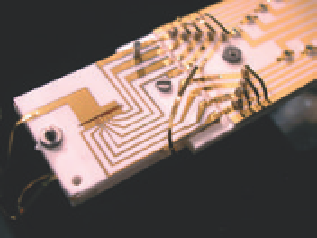Information Technology Reference
In-Depth Information
algorithm reduces the number of steps needed to find the answer from N to the
square root of N. So, for a database with a million entries, a quantum computer
could find the correct entry in only one thousand steps.
So how much progress has been made toward actually building a quan-
tum computer? It is a fast-moving field, and many groups around the world are
exploring different ways to store and manipulate qubits. In 1995 Ignacio Cirac
and Peter Zoller from the University of Innsbruck showed how the energy lev-
els of
trapped ions
could be used to store qubits and how a quantum CNOT gate
could operate on these qubits. In ion traps, ions (electrically charged atoms) are
confined by an arrangement of electric fields so that the ions are kept suspended
in space. The whole system needs to be in an almost complete vacuum, and the
ions must be cooled to near absolute zero to remove their vibrational energy.
The ions then arrange themselves in a linear array. After Cirac and Zoller's
paper, Nobel Prize recipient David Wineland's (
B.15.12
) team at the National
Institute of Standards and Technology (NIST) became the first to demonstrate
quantum logic operations on qubits stored on trapped ions. Two energy levels
of the ion are used as the qubit states, which are prepared and measured by
directing laser beams at specific ions. Coupling between the ions is provided
by the vibrational states of the ions in the ion trap. Using these techniques, the
researchers were able to isolate systems containing a few qubits and to con-
struct a quantum gate. More recently, Wineland's group stored qubits using
two beryllium ions that can be moved between different zones of the ion trap
by applying electric fields (
Fig. 15.18
). They were able to initialize and store
the qubits on the ions in any desired starting state and then perform logic
operations on the qubits. They were also able to transfer quantum information
between the different zones in the trap. Using these techniques, Wineland's
team successfully performed a sequence of four single-qubit operations, one
two-qubit operation, and ten transport operations (
Fig. 15.19
). To scale beyond
ten to one hundred trapped ion qubits, Wineland and his group have proposed
using what they call a
quantum charge coupled device
(QCCD) (
Fig. 15.20
). Its oper-
ation will require very precise control of the ion positions as they are shuttled
from region to region. Wineland's team notes that “scaling to thousands or
more qubits in the QCCD may be challenging.”
17
Although operation of such complex ion-trap systems is still very delicate,
ion-trap technology does allow the use of simple quantum algorithms. But how
close are we to creating a quantum computer that could factorize a number
with hundreds of qubits? To factorize RSA-129 with 426 bits, we would need
to build a quantum computer with close to a thousand qubits of memory that
can execute about a billion quantum gate operations. There are other problems
for would-be builders of quantum computers. Conventional computer memo-
ries suffer from the problem that individual bits can occasionally get “flipped.”
Cosmic rays, for example, are one cause of such errors. To counter this prob-
lem, the computer industry has developed a wide range of error detection and
correction techniques. A simple example is a
parity check
in which the 1s and
0s are added before and after sending a message. If a 1 has been corrupted to a
0, or vice versa, a parity check will reveal the error. Computer engineers have
devised more complicated techniques to handle situations where more than
one error has occurred and also ways of detecting which bit has flipped and
then correcting it. For qubits, we have all these problems and more. Not only
Fig. 15.18. Physicists at NIST in Boulder,
Colorado, have demonstrated sustained,
reliable quantum information process-
ing in the ion trap at the left center of
this photograph. The ions are trapped
inside the dark slit - 3.5 millimeters
long and 200 microns wide - between
the gold-covered alumina wafers. By
changing the voltages applied to each of
the gold electrodes, scientists can move
the ions between six zones of the trap.
Fig. 15.19. David Wineland's research
group at NIST designed and built this
trap to confine three magnesium ions.
A team of researchers in Innsbruck,
Austria, have now been able to store an
array of fourteen entangled qubits in an
ion trap.


Search WWH ::

Custom Search